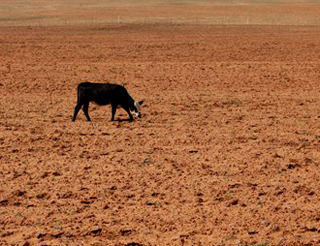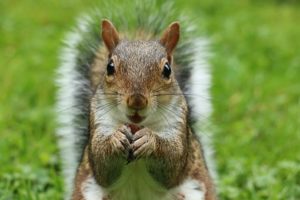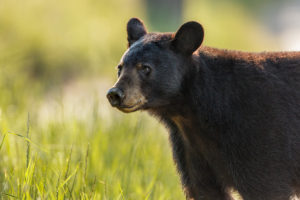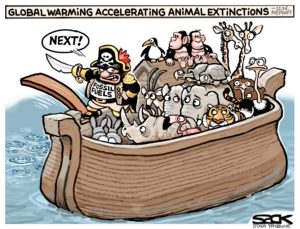Why You Should Eat Yak Instead of Beef
Cows are terribly destructive creatures, the cause of species extinction, topsoil loss, deforestation and desertification. There's an alternative you've probably never considered.
I first comprehended the awfulness of the ranching industry when the cows of Moonlight Meadows, high in the La Sal Mountains of Utah, surrounded me and began shitting. They had been trucked in from the canyons of the lowland desert countryside, near the town of Moab, to graze summer long on the free grass in the mountains — public grass, as this was land protected in trust for the American people by the federal government, under the auspices of the U.S. Forest Service. But none of it was much protected; the feces were the visceral evidence of this.
Along the trail the cows had laid big diarrheal pies, ice slippery, landmine-like, which splashed onto socks, legs and shorts. Where the trail steepened, the shit was treacherous. Soon I was surfing in it and finally was thrown like a clown on a banana peel. I lay there feeling stupid and looked around at the hundreds of cattle in the field nearby, one of many herds strewn in the mountains. A mother turned her ass to me and fired a big green load of diarrhea. Another cow pissed in an arc like a fire hose.
The cows evacuated thus onto the land and into the air, sometimes onto one another’s backs and into eyes, the shit where it had dried swirling in dust devils when the wind kicked up and where it was sloppy and wet running in streams, in puddles, in steaming black pools. The stench was ammoniacal, sulfurous, and as I lay there in my dung-splash wallow, it was, quite suddenly, an unbearable experience: not just the smell of bowels evacuating, of creatures destined for the slaughterhouse as death on the hoof, but the cultural and political travesty it represented, the ecocidal meaning of it.
Cows are terribly destructive creatures, especially in arid climates. Livestock are considered by a quorum of scientists as the No. 1 cause of species extinction, topsoil loss, deforestation and desertification in the American West. They muck or stomp or gorge out of existence streams, whole watersheds, rare grasses and shrubs, entire ecosystems in micro. Their big heavy hooves trample the soil, eroding it often beyond repair. Just as the cow is an invasive species, an exotic in the West — an import of Spanish missionaries in the 16th century — it brings invasive weeds that triumph in its midst: the water-greedy tamarisk, for example, along with the greedier Russian olive and the useless Russian thistle, better known as tumbleweed. A 1998 study from the Journal of Arid Environments found that a hundred years of livestock grazing on public lands near the White Sands Missile Range in New Mexico was more damaging in terms of long-term development and recovery of flora than multiple nuclear bomb blasts.
More than 300 million acres of public lands in 11 Western states — lands owned by the National Park Service, U.S. Forest Service, the Bureau of Land Management, the U.S. Fish and Wildlife Service and, collectively, by all Americans — are given over to the resource destruction of the cattle industry. That’s 40 percent of the landmass of the West, 12 percent of the landmass of the lower 48 states. The ranching industry controls this domain with massive subsidies from state and federal government. Even private insurance lenders such as Metropolitan Life, Mutual Life and Prudential, which in recent years have issued more than $1 billion in questionable loans to ranchers who used federally issued grazing permits as collateral, are now silent players in the subsidized ruination of Western public lands.
Public lands grazing in fact imposes a direct cost to taxpayers of more than $120 million a year, and estimates of annual hidden costs reach much higher, to between $500 million and $1 billion. The U.S. government, at the beck of ranchers, clears forests; builds roads, cattle guards and fences; diverts streams; blows up beaver dams; “improves” habitat; monitors the health of livestock; and, through the aegis of the Orwellian-monikered Wildlife Services, a branch of the U.S. Department of Agriculture, excises “undesirables” from the wilderness. These undesirables, poisoned, shot and trapped, include some 80,000 coyotes, 70,000 prairie dogs and 33,000 beavers annually. The result is continued enclosure, monoculturing and the effective privatization of the American commons — all funded by the taxpayer.
Democratic and Republican Congresses alike have defended these subsidies as the cowboy’s divine right, though in fact federal grazing provides just $1 out of every $2,500 of taxable income in the West, and just 1 out of every 1,400 jobs. Ranching on public lands in the West contributes minimally — less than 3 percent — to national beef production, as most American beef is husbanded in the temperate East. Meanwhile, the industry in the last 20 years has consolidated into fewer and fewer hands, those rich operators who can survive the exigencies of the globalization of the beef trade and the rampant land value speculation that has overtaken much of the scenic West. Today, 10 percent of the cattle operators in Montana, to take just one example, own 50 percent of the cattle in the state. These new cattle oligarchs, lobbying government to maintain their power, are the modern incarnations of the legendary barons who helped win the West in the 19th century via coercion of whole cities, corruption of officialdom, collusion with railroads and Eastern banks, rampant violence, the ecocide of buffalo and the genocide of Native Americans. The power of political cowboyism today extends even to cowing the big green conservation groups — the Wilderness Society, the Sierra Club, the National Wildlife Federation, the Natural Resources Defense Council — that have refused to tackle head-on the environmental damage from ranching.Walking out of Moonlight Meadows covered in filth, I thought of the Yahoos of Jonathan Swift, the hairy besotted humanoid cretins that defecate on Gulliver’s head as greetings. I thought of hamburgers. And I thought: Here is the commons above my home in a kind of ruin that I’d not imagined possible, certainly not from the likes of the humble homely cow, pride and fetish of the American palate. The ongoing devastation of Moonlight Meadows, this little alpine field unknown to most and mostly uncared for, is a reflection of the livestock curse not only in the West but across America and worldwide, with implications for the future of the human race. “The livestock sector emerges as one of the top two or three most significant contributors to the most serious environmental problems, at every scale from local to global,” concludes a 2006 report by the U.N.’s Food and Agriculture Organization (FAO). The FAO found that livestock production was a key contributor to land degradation, climate change and air pollution, water shortage and water pollution, and loss of biodiversity. Livestock alone accounts for 18 percent of greenhouse gas production — more than all auto travel.
So what to do about it? In an ideal world, we’d recognize that the bovine-flesh habit is a god-awful disaster and, being reasonable, we’d quit it. In an ideal world, cattle ranching on public lands in the American West would be regarded as an epochal mistake and come to its ignominious end. In return, the West, free of the cattle curse, might possibly experience one of the greatest environmental recoveries in history.
In the fallen world we inhabit, however, it’s clear we’re not quitting the bovine habit anytime soon; consumption of beef is rising planetwide, particularly in the growth-maniacal economies of China and Brazil. So perhaps a stopgap measure is to change the type of meat to feed the habit, which implies a change in the practice of ranching.
I suggest yak as our new dinner flesh. My friend Rob Williams, a newspaper publisher and professor of journalism in Vermont, helps runs a yak ranch outside the Vermont village of Waitsfield, in the Green Mountains. I went to visit him not long ago, to walk the pastures where he keeps the 45 yaks that he and his two business partners tend for the production of yak ribs, sirloin, rounds, flank, ground and sausage. “I like to think that yaks are the greenest red meat on the planet,” Rob tells me.
This is true. Domesticated 10,000 years ago in the cold harsh high country of the Himalayas, yaks survived by moving lightly on the land. They are small in stature, nimble. “Because they evolved in the mountains, they’re efficient,” says Rob. “They consume less grass per acre per animal than a cow, and get the same amount of nutritional energy. You take a single acre of pasture, you can deploy one or two cows that are larger in size. But on that same acre, you can deploy three or four yaks. Even though the yak is smaller in stature, because they consume less grass per yak, you can pack more yaks on that acre and maximize your meat production on a per acre basis.”
Rob tells me he doesn’t want to “oversell” the animals. “Still, they are pretty amazing for bovines.” Cows, for example, are disease-prone, requiring routine dosing with antibiotics. Yaks are disease-resistant and to raise them without drugging them is not difficult. They can survive at both low and high elevations, and are untroubled by cold. They eat ice for water. They cavort in snow. Cows, by contrast, tend to stand about in a stupor in high snows; they need protection from cold. Unlike cows, yaks, with their small hooves, act to aerate soil. Unlike cows, they require no human assistance at calving time. “They screw like rabbits,” Rob tells me. “We’ve doubled the size of the herd in the space of three years. We’ll expand to another six or seven animals in the next year.”
Rob doesn’t run his yaks on public lands. He is not subsidized by government. He is a tiny entrepreneur, an Eastern rancher working his own land. The typical big rancher of the American West, by contrast, is a welfare queen.
As for yak meat, Rob tells me it is healthier for human consumption than beef. This is also true. Yak meat contains roughly one-sixth the fat content of beef. It is higher in protein, lower in saturated fat, cholesterol and calories. After we’d herded the creatures to their night pasture, close by the old barn — the place was once a dairy farm, recently abandoned — Rob dipped into a freezer chest and sent me off with a pound of yak, frozen ground. Later, I mashed it into burgers with chopped onions. It was good — as good as beef.
Your support matters…Independent journalism is under threat and overshadowed by heavily funded mainstream media.
You can help level the playing field. Become a member.
Your tax-deductible contribution keeps us digging beneath the headlines to give you thought-provoking, investigative reporting and analysis that unearths what's really happening- without compromise.
Give today to support our courageous, independent journalists.






You need to be a supporter to comment.
There are currently no responses to this article.
Be the first to respond.